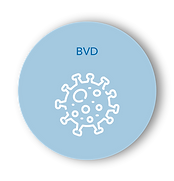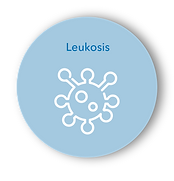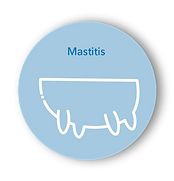
Projects of the chair in biosecurity of dairy production
The activities of the chair in biosecurity of dairy production revolve around three research themes.
Validation of rapid, robust and effective diagnostic strategies to support the implementation of rigorous biosecurity programs.
THEME 2
Development of effective and economically viable monitoring programs and tools for control of diseases.
THEME 3

Identification of key biosecurity practices to prevent the introduction or spread of disease between herds (external biosecurity or bio-exclusion) and to control within herd prevalence.
THEME 1


BVD is an endemic, often underdiagnosed infectious disease that threatens the profitability and sustainability of dairy farms.
This disease has a significant impact on animal welfare and on the use of antimicrobials and food safety. Therefore, it is crucial to implement biosecurity plans based on solid scientific evidence.
Infection of Bovine Viral Diarrhea Virus - BVD
-
Describe the prevalence of BVD infection and identify the practices associated with the probability of infection in a herd
-
Evaluate the diagnostic performance of different approaches to determine the status of a herd with respect to BVD
-
Establish the basics and evaluate different control approaches for BVD infection.
Surveillance of Bovine Viral Diarrhea
in Canadian dairy herds
TEAM
To do this
Objective
To develop a monitoring and control program for BVD for the benefit of cattle, dairy producers and consumers.
Results
The results of the research will be essential for the development of better programs to prevent disease transmission. Dairy producers, veterinarians and governments will have new working tools for the control and, in some cases, the eradication of other infectious diseases.

-
Describe the biosecurity measures in place
-
Explore the implementation of the recommendations suggested by the referring veterinarians
-
Identify the motivations and difficulties of producers for the implementation of biosecurity practices.
Methodology to assess the adoption of biosecurity practices on Canadian dairy farms and identification of barriers to their implementation
TEAM
To do this
Objective
To assess the adoption of biosecurity practices on Canadian dairy farms and identify barriers to their implementation.
Results
The results of the research will make it possible to understand the causes and the difficulties the producers may face that prevent a better implementation of biosecurity practices and to propose strategies to overcome some of these difficulties and increase biosecurity on canadian dairy farms.
Biosecurity measures
Biosecurity measures applied in animal production can limit the transmission and spread of infectious diseases, bringing a series of benefits, such as reduced antibiotic use, better milk quality and animal welfare.
Despite the benefits, it is unclear why the use of biosecurity measures is apparently low on dairy farms in Canada, given the dangers of introducing disease.
Résultats
The results will provide new insight into the biosecurity practices implemented on farms. They will enable us to adopt a targeted approach to disease control based on the different farm profiles highlighted. Finally, it will enable us to adopt a preventive approach to farms considered to be at risk.
TEAM
To do it
Objective
Based on the biosecurity profiles of Canadian dairy farms, characterize dairy farms and determine their status with regard to various diseases.
Biosecurity
Biosecurity is the set of practices used to limit the introduction and spread of pathogens on a farm.
Information on biosecurity measures is mainly collected using risk assessment questionnaires. These questionnaires can potentially predict the infectious status of a herd, but their analysis is complex due to the high number of variables.
Machine learning is therefore proving to be an interesting alternative for dealing with data from biosecurity questionnaires.
Development and validation of classification models to determine the status of dairy herds for high-priority infectious diseases in the Canadian dairy industry
-
Describe the combinations of biosecurity practices that are most frequently implemented on farms, using association rule algorithms.
-
Classify herds according to their biosecurity profiles
-
Develop and validate classification algorithms for predicting herd disease status.
-
Carry out a cost-benefit analysis of biosecurity profiles




-
Validate a bulk milk ELISA test to determine within herd prevalence of leukosis
-
Estimating the within herd prevalence of leukosis in Canada
-
Determine the association between biosecurity practices and within herd prevalence of leukosis in Quebec
-
Compare the within herd prevalence observed in 2022 with the one reported in 2018 in Quebec.
Development of a surveillance and control program for bovine leukosis in Canadian dairy herds
TEAM
To do it
Objective
To develop a bovine leukosis surveillance and control program in Canada.
Results
The results of the research will make it possible to propose better management practices and propose a monitoring and control program of the disease. Dairy farmers, veterinarians and governments will have new working tools to fight bovine leukosis and, in some cases, eradicate other infectious diseases.
Bovine leukemia virus
BLV
BLV affects the health and production of dairy cattle. BLV-positive herds encounter barriers to international trade with countries where the disease is eradicated. Disease prevalence is directly associated with biosecurity.

-
Estimate the prevalence of MAP and associated risk factors in Canadian dairy herds.
-
Determine the diagnostic performance (sensitivity and specificity) of bacterial culture and PCR on environmental samples, and of ELISA on reservoir milk, in detecting herds with PAD.
-
Propose strategies for the detection of MAP in dairy herds that are efficient, economically sustainable, easily applicable and in line with stakeholders' objectives.
Prevalence and evaluation of screening strategies for Mycobacterium avium subsp. paratuberculosis (MAP) in Canadian dairy herds Introduction
TEAM
To do it
Objective
Propose cost-effective strategies that meet the objectives of stakeholders (producers, veterinarians, government) for the detection of MAP in dairy herds.
Results
The results of my research project will enable comparison of the prevalence of MAP over time and in the same region; estimation and comparison of the diagnostic performance of tests in the same population and reflecting the target population; and identification of the most accurate and cost-effective environmental samples for MAP screening. All of the knowledge gaps identified by the experts as hampering the success of MAP prevention and control programs worldwide.
Stakeholders will have at their disposal strategies for the detection of MAP-affected herds in line with their objectives that can be adopted in Johne's disease prevention and control programs.
MAP
MAP is the causative agent of paratuberculosis, an infectious, chronic, incurable disease of ruminants, characterized by granulomatous enteritis.
MAP causes major economic losses in dairy herds and is associated with Crohn's disease in humans. Although causality has not been proven, this association is cause for concern, as MAP has been isolated from products intended for human consumption, such as meat, raw and pasteurized milk.
The evaluation and improvement of biosecurity measures to prevent the introduction and spread of MAP within and between herds requires cost-effective screening strategies.


-
Describe the fine variation over time in the DSCC of individual milk samples from cow quarters, depending on their real infectious status, parity, days in milk, and quarter location.
-
Describe the relationship between DSCC and milk production of a quarter.
-
Identify referential values of DSCC for healthy quarters and quarters with subclinical mastitis.
-
Estimate the diagnostic accuracy of DSCC for the diagnosis of intramammary infections in dairy cows, on individual quarter samples, using Bayesian approach.
Evaluation of the added value of differential milk somatic cell counting for the diagnosis of intramammary infections in dairy cows
TEAM
To do it
Objective
Investigate the added value of differential somatic cell count for the detection of intramammary infections.
Results
This study is expected to provide valuable insights into the diagnostic accuracy of DSCC for managing intramammary infections in dairy cows. By evaluating its association with important covariates, relationship with milk production, and diagnostic accuracy, DSCC may serve as a tool for improving mastitis detection and overall udder health management.
Diagnostic
Accurate and reliable diagnostic tests are essential for the effective management of mastitis in dairy herds, as the success of treatment depends on timely detection and appropriate intervention. Somatic cell count (SCC) is widely used as a key indicator of udder health, providing a general measure of inflammation in the mammary gland.
Elevated SCC levels are associated with intramammary infections, making it a valuable tool for identifying cows with subclinical or clinical mastitis.
Emerging diagnostic tools, such as differential somatic cell count (DSCC), may offer the potential to enhance the accuracy of mastitis detection by providing additional information on immune cell composition.




-
Assess the current prevalence of S. Dublin
-
Estimate the accuracy of an antibody test (ELISA) to determine the status of a herd with: 1 bulk milk, blood from 10 animals, environmental samples
-
Examine different diagnostic strategies and estimate their costs
-
Order the diagnostic strategies and propose the optimal ones thanks to the multi-criteria decision support tool
-
Identify risk factors for S.Dublin
-
Look for the presence of geographical "clusters".
Validation of tank milk sampling strategies and study of risk factors for Salmonella Dublin in dairy herds
TEAM
To do it
Objective
To validate bulk milk sampling strategies and identify risk factors for Salmonella Dublin on dairy farms in Quebec.
Results
Research results will help guide dairy producers and their veterinarians in choosing a testing scenario using ELISA on bulk tank milk and/or other types of samples/analyses to predict the status of their herd. In addition, the industry will have specific biosecurity recommendations to prevent introduction of S. Dublin into negative herds and mitigation strategies to control within herd prevalence. Finally, governments will have new tools to tackle this disease.
Salmonella Dublin
Salmonella Dublin is a zoonotic enterobacteriaceae that emerged in dairy cattle in Quebec in 2011. The Dublin serotype is adapted to cattle; which leads to the presence of asymptomatic carriers which will contaminate and maintain the circulation of the pathogen in a herd. Bulk tank milk seems to be very useful for diagnosing the disease. However, the optimal diagnostic strategy to predict the status of a herd needs to be clarified.
Additionally, biosecurity appears to play an important role in the introduction of S. Dublin. Therefore, the link between the status of a herd and its biosecurity practices remains to be investigated.

-
Estimate the prevalence, incidence, and elimination rate of intramammary infections caused by pathogens other than Staphylococcus spp.
-
Evaluate the impact of these infections on somatic cell score (SCS), potential milk losses associated with these infections, and their impact on milk components.
Dynamics of mastitis pathogen infections and their impact on somatic cell score, milk yield, and milk components
TEAM
To do it
Objective
Evaluate the impact of intramammary infections caused by pathogens other than Staphylococcus spp. on somatic cell score, milk yield, and milk components in dairy cows.
Results
The results of this research can provide valuable insights into identifying key pathogens of concern, helping farmers and veterinarians focus on these pathogens to improve udder health and optimize management practices on dairy farms.
Mammite
Mastitis is a common and costly disease in dairy herds, caused by various pathogens that compromise mammary gland health and affect milk production.



-
Classify S. aureus into persistent or transient based on the following case definition: a quarter had to show at least five positive samples for S. aureus during the collection period to be classified as having a persistent infection. In contrast, a short-term infection classification required a series of two negative samples followed by one positive sample, then two additional negative samples.
-
Apply machine learning to predict persistent infections using the MALDI spectra.
Identification of persistent Staphylococcus aureus infections using MALDI-TOF mass spectrometry and machine learning
TEAM
To do it
Objective
This project aims to use MALDI-TOF mass spectrometry combined with machine learning to predict whether a S. aureus isolate will result in a persistent infection.
Results
This research can help to provide a efficient method for identifying persistent S. aureus infections in dairy cows. By distinguishing between persistent and transient infections, farmers and veterinarians could make more informed decisions about treatment and management strategies. This could lead to improved udder health and ultimately reduced antibiotic use.
Mammite
Persistent infections caused by Staphylococcus aureus pose a significant challenge in dairy herds, as they are difficult to treat and can lead to chronic mastitis.
Traditional diagnostic methods cannot distinguish between isolates that will cause transient versus persistent infections.

























